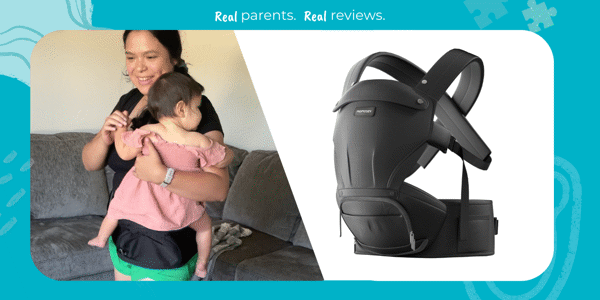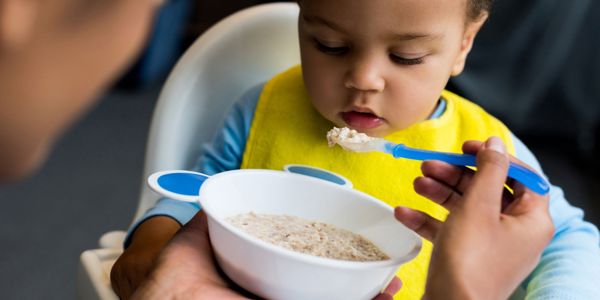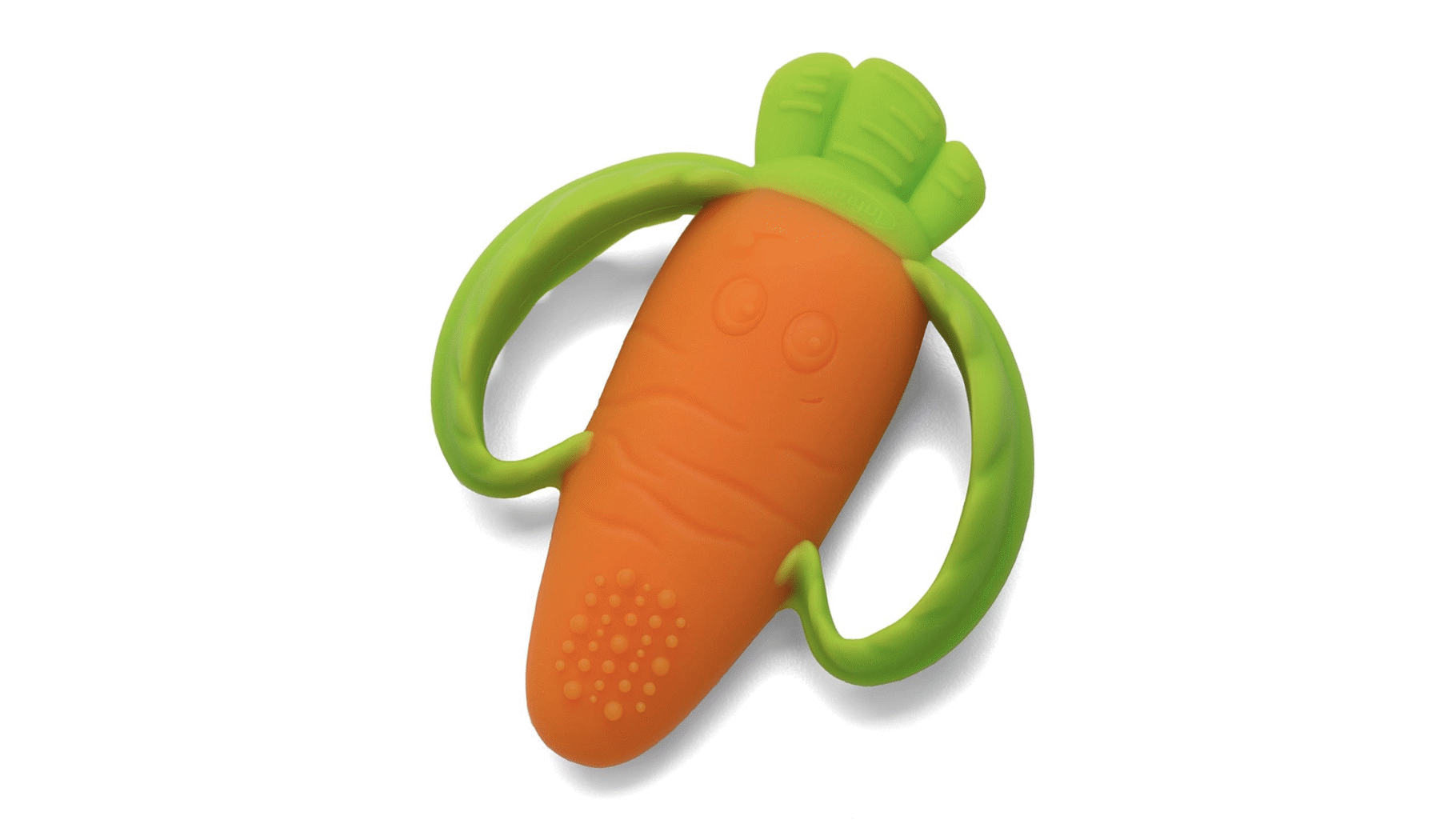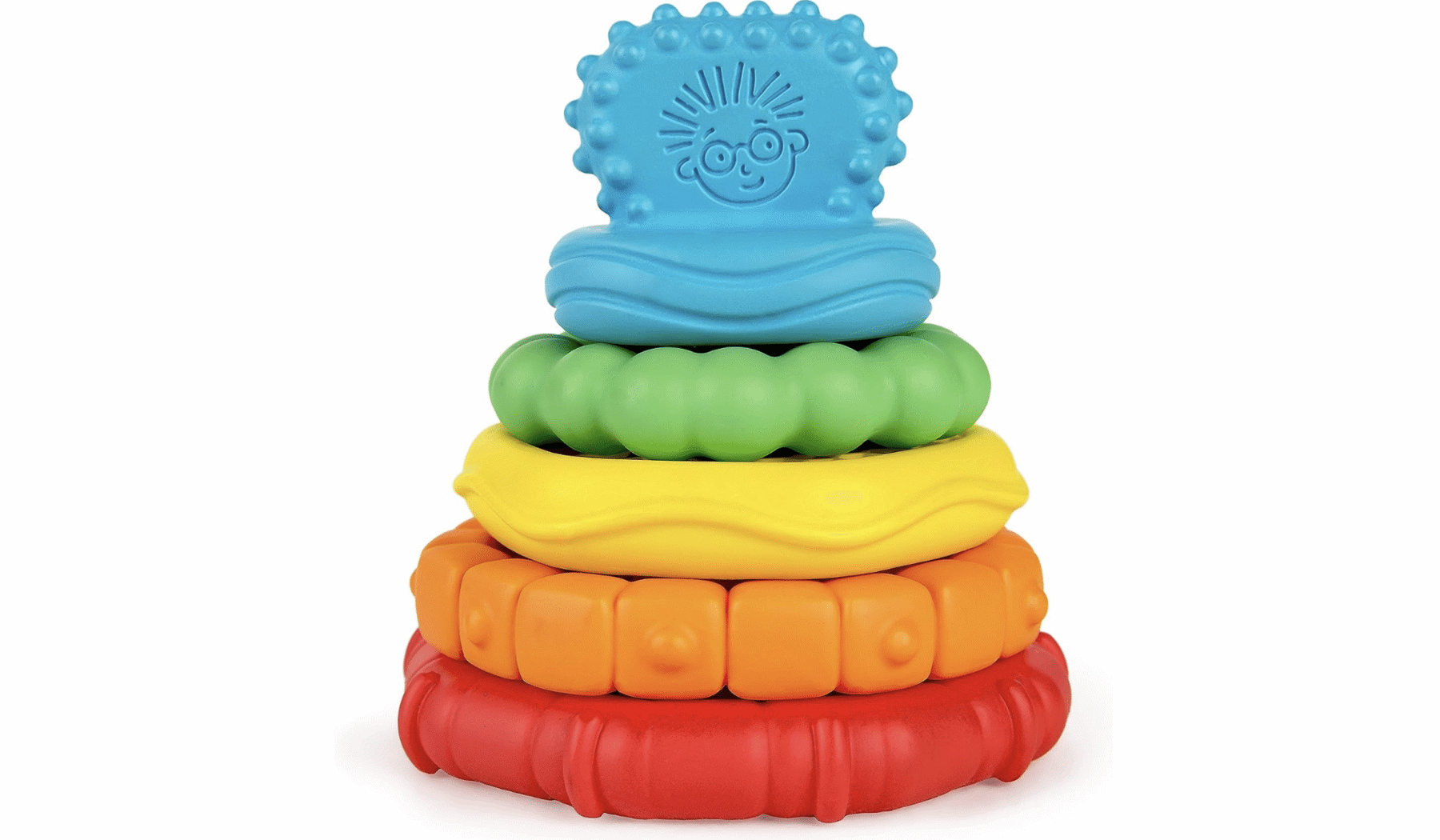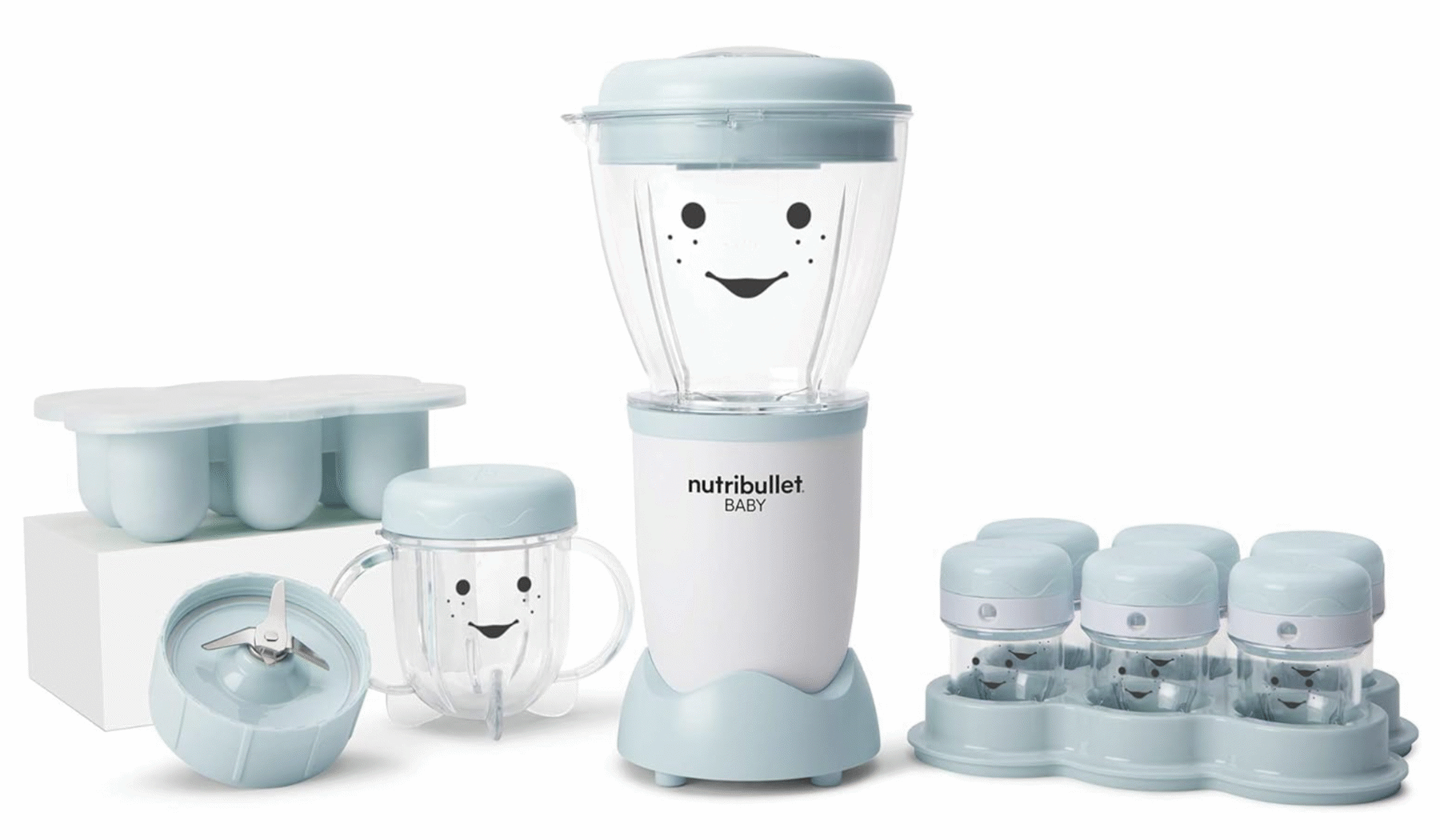Congratulations, you have officially made it six months! Your little social butterfly may interact with anyone and anything they can at this stage.
You can continue to expect lots of changes from your baby, and they may even speak their first word soon! As your little one becomes more independent by the day, you might feel mixed emotions of pride and sadness that they are growing so fast. It is a sentimental stage, but continue providing them with encouragement and support as they master new skills each week.
At this point, your baby's brain can recognize more things than ever. Each week, they will learn something new. Your little one will watch what you do and say with amazement. Watching you will help them understand what sounds or gestures receive a response from others. Your baby is becoming more observant; they will notice others smile back when they smile.
When they cry, they will learn that it gets attention from others. Certain syllables will come to them easier than others, and they will enjoy repeating them once they know how to. Encourage them to practice by repeating any new sounds they make; it will benefit their language development.
Milk should still be your baby's primary food source at this time. Breast milk or formula will give your baby all the nutrients they need to grow. Whether you breastfeed, formula feed, or use a mix, feeding your baby milk before introducing new foods will ensure they are nourished. After satisfying their appetite with milk, you can attempt to introduce foods like purees.
Your baby will not be able to satisfy all their nutritional needs from solid foods at this time, which is why they will still need their milk meals first, but if you feel compelled to begin the weaning process, you can slowly start. For the time being, it will take your baby time to perfect eating as they learn to chew, take bites, swallow, and bring food to their mouth. As they grow, the process of digesting food will become easier for them as well. All babies are different, but if you feel that yours is ready to start incorporating soft fruits and vegetables or purees into their diet, try it!
At this stage, many babies have learned to sit up without support. This newfound skill provides them with a new perspective on seeing the world around them and allows your little one's hands to be free for play and exploration!
Rolling is also a common accomplishment at this stage. If your baby has mastered sitting up well, you might find them effortlessly rolling around the room to reach their favorite toys or explore their surroundings. As well as sitting and rolling, some babies may start showing signs of shuffling around on their tummy or even on their bottom.
While not all babies adopt this method of movement, it is an important stepping stone towards crawling. It indicates a growing sense of independence and mobility.
Congratulations, Mama! It has been more than six months since you gave birth to your little bundle of joy.
By now, you are likely getting the hang of this whole parenting thing and feeling well-adjusted and more confident in your parenting skills! Childbirth and pregnancy will take a toll on your body and cause your hormones to go crazy.
You may be dealing with a postpartum hormone imbalance if you still don't feel like yourself. Some symptoms of common postpartum hormone imbalances include but are not limited to, prolonged anxiety or depression, chronic fatigue, cysts, and low libido.
Certain medications are available for some conditions, including hormonal imbalances in the thyroid, but often, these issues will resolve themselves. The chances of experiencing a hormone imbalance after pregnancy are higher if you have ever dealt with one prior to it. Consult your doctor if you have any worries or experience any of these prolonged symptoms.
As you reach around half a year post-surgery, your scar will likely have faded, but it might not have fully matured. Remember that everyone's healing process is different; some scars may take longer to become less noticeable. Try to embrace your scar and not let it become something you feel the need to try and hide. Your body has done a fantastic thing, and the scar is evidence of this.
You'll probably notice your core strength improving if you have been active since birth or have returned to exercising. Your abdominal muscles undergo significant stretching during pregnancy and c-section surgery, and it's normal for this to take some months to rebuild.
As a busy parent, finding the time to exercise is as challenging now as it has ever been before. Exercising may not be at the top of your to-do list with all your other priorities, including keeping your baby entertained. However, it is still important for your physical and emotional well-being. Exercising with your little one can be a fun activity for both of you; in some cases, you may not even notice you are working out!
We do not expect you to run on the treadmill or lift heavy weights with your baby, but dancing to music and jumping around can be fun for both of you. Not only will your little one be grinning from ear to ear and giggling as you dance with them, but they may even develop a passion for music in the process!
Always keep the volume low, even if your favorite song comes on, and remember that your baby's ears are far more sensitive than yours.
Other ways to exercise with your baby include watching YouTube videos involving singing and dancing. Believe it or not, some of these videos will have you burning more calories than expected.
As you begin introducing fruits and vegetables to your child's pallet, you may wonder where to start. If your baby is ready to indulge in solid foods, here are some tips to help you!
At this stage, bibs are going to be your best friend. This milestone is messy, so as your baby begins showing signs she is ready to try solids, invest in a few. For those who want to make homemade purees at home, there are three factors you must keep in mind: nutrient density, digestibility, and taste variety.
Your baby is still developing, so they need all the nutrients their little digestive system can take. To avoid having a picky eater on your hands, incorporate a wide variety of flavors and textures into your baby food. This will help expand their appreciation for different foods. Bananas and avocados are two great options to introduce your baby to, either on their own or mashed together.
Start by scooping half of a ripe avocado in a bowl to make this healthy, fat-filled, prebiotic, and potassium-dense combo. Add a ripe banana to that same bowl and mash them with a fork. If your baby likes things on the smoother side, don’t hesitate to add some breast milk to the mix! This puree is a sweet and fatty combo that your little one will surely enjoy and benefit from!
Your little one is becoming more and more mobile! As your baby enters this week, you may see some teeth growing in, making eating solid foods much easier for him. Enjoy watching your baby flourish as their motor skills and attention to voices improve this week.
By this week, your little one has surely gotten used to moving their tiny fingers around with more control. Having control of their fingers will help them easily grab food, sippy cups, smaller toys, and bottles on their own. You can expect your baby to continue wanting to do things independently; they will roam around different areas and rooms, exploring their surroundings.
With their increased independence and curiosity, they will be amused by everyday items as simple as the legs on your living room couch, as well as anything else in their eyesight. Watch them discover new things around the house with amazement. They may even sit up on their own for several moments; the first time they do this without assistance will be exciting for everyone!
Your baby may have already begun imitating certain sounds you make, or at least attempting to! As their hearing develops and strengthens, your little learner will continue to improve at mimicking sounds. Babbling sounds and simple vowels can be expected from your little one at this stage. However, they will still have limited speech-making abilities. Since vowels and short sounds come easily to babies, common first words are “Mama” and “Dada”!
Your baby will start reacting to new or unfamiliar sounds as their hearing senses develop rapidly. Even though they can’t speak or form words yet, you will likely be able to easily decipher their sounds and attempts at forming words.
If you have suspicions about your baby's response to sound or worries about hearing development, bring them to a speech-language pathologist. Doctors can perform hearing tests on your child and rule out possible problems.
Continue to encourage your baby to be independent this week; they will likely enjoy doing things independently now that their increased mobility allows them to. Since they have more control over their little hands and fingers now, grabbing food and bottles, feeding themself, and even holding their own spoon are all things you can encourage them to practice!
Thanks to advancements in your little one’s gross motor skills, they might be crawling and sitting up on their own soon. Keep in mind that as your baby becomes more mobile, baby proofing the house becomes essential.
A crawling baby will grab almost anything they can reach and put it in their mouth without hesitation, so try to reduce the possibility of any accidents occurring by removing dangerous items and covering all outlets.
There are a few signs to look out for to show that your little one is ready to start weaning:
When it comes to weaning, you have two main approaches: baby-led weaning and traditional weaning. Each method has its benefits, and the decision ultimately depends on what you and your baby are comfortable with.
Baby-Led Weaning: This approach encourages letting your baby explore solid foods independently. Offer age-appropriate finger foods that are soft, easy to grasp, and safe to eat without the need for teeth. Suitable options for baby-led weaning include steamed vegetable sticks (carrots, broccoli, sweet potato), soft fruits (bananas, avocados, ripe pears), and cooked pasta or rice.
Traditional Weaning: Parents or caregivers gradually introduce pureed or mashed foods to their babies. You can start with single-ingredient purees like mashed bananas, cooked and pureed vegetables (peas, sweet potatoes), or baby rice cereal mixed with breast milk or formula. As your baby becomes more accustomed to eating solids, you can begin combining flavors and textures.
To ensure a smooth transition to solid foods, it's important to be prepared. Here are some essential things you'll need to help you get ready for weaning.
Now that you have been parenting for half a year, you are likely getting the hang of things! If you find yourself stressed out or overwhelmed at times, the best thing you can do is step away and take a moment to calm yourself down. It is easier said than done, but it is also important to remain calm and relaxed in stressful situations, whether you are alone or with your baby.
Your little one can pick up on your stress as well as take after you by watching how you handle situations. A calm parent means a calm baby, so try not to set the example for your little one that getting angry when you are stressed is how to deal with emotions. Take time for yourself to calm down, and do not feel guilty for needing alone time or privacy.
You are a wonderful parent; if taking space for yourself or hiring a nanny will provide a healthier environment for your family, do what is best for you. Your little one will probably love their caretaker if you choose to hire one, and it may even make your heart melt to see. If you get jealous that your baby is creating another bond with someone, remember that this means they feel safe and happy in their care, and never feel guilty for taking care of yourself!
While the initial postnatal recovery period is well-documented, it's equally important to consider the long-term physical recovery six months after childbirth.
After a vaginal childbirth, the pelvic floor muscles should be well on their way to healing. Still, it's essential to continue strengthening them. Kegel exercises should still be your best friend! These exercises are vital in toning and regaining control over these muscles. A strong pelvic floor helps with bladder and bowel control. It supports the pelvic organs, preventing issues like prolapse in the future.
The abdominal muscles also undergo significant stretching during pregnancy, and it takes time to regain strength. Gentle abdominal exercises can be introduced, but you should still avoid high-impact activities to prevent injury. If you’re looking to get back to high-intensity exercise, always speak to your healthcare provider beforehand.
Remember, everyone's body heals differently, so listen to your body and progress at a comfortable pace.
Musical toys are a great activity now since your little one's hearing is developing rapidly, keeping them entertained for extended periods of time. If the musical toys your baby plays with have different buttons for different sounds, they will also teach them cause and effect!
After watching you demonstrate how to get the toy to make certain sounds, your baby will try to do the same. Playing with toys like this will help your little one learn the effects of their actions, and they will quickly remember which buttons cause which effects.
Other musical toys without buttons or that aren't electronic are also great for helping your little one learn. Shaking a rattle back and forth will help your baby's hearing further develop as they learn how to decipher where the sound you are making is coming from.
Singing to your baby can also be a fun and silly activity for both of you. If you struggle to get your little one to cooperate with things like cleaning their face off after eating or changing them, singing songs while you do these tasks can make them more bearable for both of you. Singing to your baby will strengthen your bond, make them happy, and teach new words!
Soon enough, your little musician might even attempt singing, babbling, or humming along with you. Songs are a great way to communicate with your baby at this stage while simultaneously teaching them new things!
If you have already begun the introduction of sippy cups, this likely means that your little one is drinking water by now. Some mothers introduce water to their baby while they are still nursing, but others wait until their baby is ready to start using a sippy cup.
To avoid any unnecessary accidents or injuries, make sure your house is baby proofed for your little explorer. Other tips for ensuring your baby's safety as they become more mobile include practicing safe changing. Since your little one is rolling like a pro by now, you may consider moving their changing station to the floor instead of using a high changing table, especially if it doesn't have at least a two-inch guard.
Moving your baby's changing station to the floor will allow your nerves to remain calm as you reach to grab whatever it is you need without fearing they may roll off if you look away.
To encourage your little one's independence, try letting them hold a spoon if they are already good at grabbing soft foods with their hands. Using a spoon will be quite messy, so stocking up on bibs is a must, but this will teach your baby new skills while helping them master eating on their own!
Wow, your little one is almost seven months old! Where has the time gone? By now, your growing baby will be as hungry as ever! Their feeding needs will continue to increase and become more demanding, as well as the number of times they wake up throughout the night needing food. As they continue to develop physically, emotionally, cognitively, and socially, your little one's individual personality will grow too. Babies are still growing and developing at their own pace, which is why the timeline for reaching milestones varies from baby to baby.
As your little one begins gaining fat and continuing to grow, you may notice some changes to the texture of their skin, including it becoming softer with weight gain! As their personality begins to shine, help them adopt healthy habits and practice remaining calm when things don't go their way. Keep this in mind for yourself, too, since they will watch you and take after you.
If your child is a late bloomer, they may still be working on crawling, while others have possibly mastered the skill and moved on to practicing sitting up. As long as you see improvements, even small ones, just keep motivating him; they will catch up soon.
Your baby is also beginning to understand facial expressions and tones related to emotion. This means your little one will be able to sense tension when you are annoyed or frustrated. Your emotions or frustration may affect your child’s emotions, which is why trying your best to remain calm is the key.
As their understanding of emotions advances, this also means they will be able to pick up on things that make you happy or smile. Your baby will likely remember things that they do that make you giggle or make you excited. Soon enough, your little one will be able to understand which vocal tones or expressions correspond with feelings such as being surprised, scared, happy, confused, and more.
By now, your baby is ready for solid foods and has most likely already begun trying some. When introducing solid foods to your baby, many pediatricians and food allergists support daily exposure to common food allergens! Others suggest waiting until your child is one year old, so the choice is ultimately yours.
Exposing your baby to allergens in a safe setting early on in their life can help their chances at a healthier and safer future. Early food allergen introduction can be nerve-wracking for new parents, so some feel the safest place to do it is the hospital parking lot. This is unnecessary, but we understand if it calms your nerves. Now is a great time to embark on your food allergen exposure journey.
Common allergens include peanuts, eggs, dairy, wheat, soy, fish, and shellfish. When introducing allergens, consider the following tips:
Your baby is growing rapidly and experiencing new changes every day. These new milestones include teething, which can be both exciting and challenging for a parent.
As new teeth emerge, your baby may exhibit several teething symptoms, including:
Caring for your baby's new teeth ensures oral health as they grow. As soon as your baby's first tooth appears, you can start gently cleaning it with a soft, damp cloth after feeding. This helps to remove any residue and protect the teeth from bacteria.
Around this stage, you can introduce a baby toothbrush with soft bristles. Use a tiny smear of fluoride toothpaste (no larger than a grain of rice) to brush their teeth twice a day if the age on the toothpaste says it's safe to use.
Opt for teething toys made of safe materials that are easy to hold and not too hard that they damage any teeth already emerging. Chilled (not frozen) teething toys can provide additional relief to sore gums.
As your baby becomes more independent and easily occupied, you may find yourself able to sit on the couch as you watch him play rather than having to move their toys for them and demonstrate how to use them.
Now that your little one can spend longer playing with things, taking care of quick household tasks may become easier! Playing with your baby and interacting with them is still important, but if they keep busy for a few minutes here and there, take advantage of it!
Sit down on the couch a few feet from your baby while they play with the sensory toys you've gathered for them. You can watch them from the couch while they play with this toy. As long as they are safe, there is no need to hover over them. If you are still trying to get your pre-pregnancy body back, put a stretching video or a quick workout video on the television.
You can follow along with the video next to your baby as they enjoy their sensory toys. Doing this will allow you to be in the same room as your little one with eyes on them while also benefiting your physical and mental well-being! Even if your baby is not distracted long enough for you to finish the video, this is a great opportunity for you to try this out.
While many people associate postpartum depression and other postpartum mental health concerns with the immediate aftermath of childbirth, this isn’t always the case. Symptoms can manifest at any point after giving birth, and many parents don’t actually spot that they might be suffering for up to a year after giving birth.
While it’s normal to experience some changes in your mood, it’s important to keep an eye out for the symptoms of maternal mental health issues.
No list of symptoms can be exhaustive, and everyone can experience mental health struggles in different ways. If you're experiencing any of the symptoms of common postnatal mental health problems or simply feel that something isn’t quite right, reaching out for support is essential. In the US, resources are available to help parents with postpartum mental health concerns.
The first step is to reach out to your healthcare provider. They can assess your symptoms, provide guidance, and refer you to appropriate mental health services.
If you are running out of ideas for occupying your baby and want to provide fun and stimulating activities for them, we’ve got you covered!
Did you know you can make your own sensory bags for your baby to play with that are catered to their interests, all with items found around your house? A mess-free activity you can set up for your child that is practically free is a simple ziplock bag filled with ice and a little bit of water. After making this, tape the corners of the repurposed ziplock bag to the floor and watch your baby move the ice cubes around, giggle, and even slap it.
This activity is affordable and will occupy your little one while stimulating multiple senses simultaneously. If your baby isn’t a fan of the cold sensation, or you just want to explore other activities like this, try filling a separate bag with either hair gel or water and putting things like beads, pom poms, seeds, and small toys inside it. Watch your child light up as they play with these homemade toys with fascination.
Early allergen introduction evolves as your baby does, and introducing a variety of new foods can even help boost your little one's immunity! The most common food allergens include peanuts, eggs, wheat, soy, tree nuts, dairy, and seafood. When introducing certain foods such as nuts to your baby, you can safely give them a small amount of nut butter rather than the physical nut.
Any time you give your baby one of these common allergens for the first time, make sure only to offer a minimal amount to decrease the chances of a bad allergic reaction. For picky eaters who won't cooperate with this process, try mixing an eighth of a teaspoon of the allergen you are introducing into a food your child already eats, such as oatmeal.
When giving your baby an allergen for the first time, ensure you have no distractions. Plan out a time when you will not be distracted or interrupted for at least two hours after giving your baby the allergen so that you can observe him with your full focus. Only introduce one allergen to your baby at a time throughout this process.
If you give your child multiple allergens at once and a reaction occurs, you will not know which food was responsible for it and will have to repeat the traumatic process.
Even after introducing the food once, keep the serving size small for a while since not all babies have an allergic reaction the first time trying an allergen. Once you have determined whether or not an allergy is present, incorporate the food into your baby's regular meals to prevent an allergy from developing. Do not worry if your baby doesn’t eat it every day; keep offering it to them consistently. Even exposure to the food once a week is beneficial!
Wow, your baby is almost seven months old! By this week, your little one is an entirely different baby than the one you brought home from the hospital! Your child is continuing to explore around the house. Babies will have various means of moving around, whether rolling, scooting, or crawling, so keep monitoring your baby and picking up any small objects that they can easily choke on. Soon, your little one may even start pulling up to a standing position thanks to their increased strength, brain control, and interest in trying new things.
Your little one will still be easily occupied this week, and with their high energy levels, they might need less downtime. As their appetite continues to increase, their energy levels, movements, and brain development will too. All these things require your baby to maintain and improve their energy and strength, which they can get from food.
Teething might get in the way of their progress and advancements as it will likely cause them discomfort and irritability, as well as interfere with their sleep schedule and their appetite. Try to keep your baby calm through this process and pay attention to any signs of discomfort they express.
Pay attention to your baby’s mood this week and note any behavioral changes you see. Teething is common at this stage and can cause severe discomfort for your little one. If you notice your baby's gums are red or swollen, you can give them a cold teething ring to ease the pain. Providing your baby with cold foods and teething toys throughout this process will help ease their toothaches and discomfort.
Some obvious signs that your little one’s teeth are starting to come in include them drooling more than usual, running a low fever, acting fussier and more irritable than expected. Difficulty sleeping may become a problem again while your baby's teeth continue breaking through, and they may show a decrease in their appetite. Try not to become too frustrated by this, even though you were probably just getting into a regular schedule and routine for feeding and sleeping. It is okay to do a bit of backtracking at this time.
The teething process is uncomfortable for your little one. Keeping your baby calm and helping to relieve their pain is the priority at this time. This can be done by giving them cold foods, teething toys, and medications with a doctor's approval or softly massaging their gums.
They will likely be irritable, but remember that they are getting better at reading your emotions, so do not let your frustration show but instead show your baby love and support throughout this process.
You will notice your baby is becoming stronger by the day! You may even see that they bear weight in their legs when you lift your little one above the ground. The weight on their legs and feet will stimulate your baby's muscles and help them develop strength and gross motor skills.
As their muscles become stronger, crawling will become easier for them. You might notice some decorations or other items missing from low shelves now that your curious crawler is on the move.
By this stage, you can begin to encourage your baby to play with their toys while they sit upright rather than lying on their tummy. If their muscles allow them to do so, provide a few pillows to help prop them up and sit on their own! Helping your baby transition to this playing position will build their core strength and make them more independent.
You may notice your baby experimenting with a new and exciting position – sitting on all fours! This is a crucial first step in their journey towards crawling and exploring the world around them. This position helps to build their back and abdominal muscles, which are vital for maintaining an upright posture and supporting their body weight when on the move.
As your baby rocks back and forth while on all fours, they are also refining their balance and coordination skills. The rhythmic movement helps them learn to distribute their weight properly between their hands and knees, preparing them for the much more complex task of crawling.
While some babies might show these signs of starting to crawl around this time, it's more common for this milestone to occur around nine months. Encourage crawling by creating a fun and safe space with toys and cushions to motivate your baby to move around between objects.
If you do notice your baby sitting on all fours and rocking, offer gentle encouragement and praise. Celebrate their achievements and be their biggest supporter during this exciting phase of development!
By this stage, most babies will need anywhere from twelve to sixteen hours of sleep every 24 hours, split into night sleep and naps. Getting plenty of sleep is crucial during this phase, as it helps with brain development, memory consolidation, and overall physical growth. With your little one sitting up, rolling over, and moving around more than in previous months, they’ll be using up a lot more energy!
You may notice some changes in your little one’s sleep patterns soon. This period is often associated with sleep regression.
The six-month mark is a typical time for sleep regression to occur due to the significant developmental changes taking place in your little one.
Around this time postpartum, mothers will be experiencing different physical and mental feelings. If you gave birth via C-section, you might be more fatigued at this stage than a mother who gave birth vaginally. Most women have lost around half the pregnancy weight they put on by now, but it could vary depending on several factors. Every mother’s postpartum body is different.
Any dark spots or stretch marks you have will begin to fade if they haven’t already, and if you had a linea nigra or a dark line down your abdomen, that will fade too.
By this month, you may notice significant improvements in your body's recovery. Many women experience reduced postpartum hair loss and increased energy levels during this period, and a lot of other postpartum symptoms should start coming to an end. However, keep in mind that individual recovery timelines can vary, and it's crucial to listen to your body's needs.
Reaching this mark as a mom is a fantastic achievement and one you should recognize. Recovering from childbirth, adjusting to life as a parent, and keeping your little one happy and healthy is an amazing feat.
This week's activities are about helping your little one’s strength and mobility continue to advance. A fun activity for your baby that will help their legs develop faster is bouncing them on your legs. While it is unlikely that your baby can stand on their own, they can support some weight on their legs by now! Start by holding your baby upright with their feet on your thighs as you sit and support them under their arms.
This is a great activity, but if they start bouncing around, support their underarms and help them continue doing so!
Now that your baby is more mobile and can move around more easily, try letting them crawl to retrieve their toys rather than doing this yourself. If your little one enjoys throwing things, encouraging them to retrieve them independently is extremely important.
Allowing your child to throw things will help their arms continue to develop. Having your baby retrieve their own toys is a great little workout for them. The more they move around and become familiar with doing so, the better they will become at it.


The information on the Your Baby Club website is not intended to be a substitute for professional medical advice, diagnosis or treatment. Always discuss any health concerns with a qualified healthcare provider and carefully review all guidance that comes with any medications or supplements before taking.

